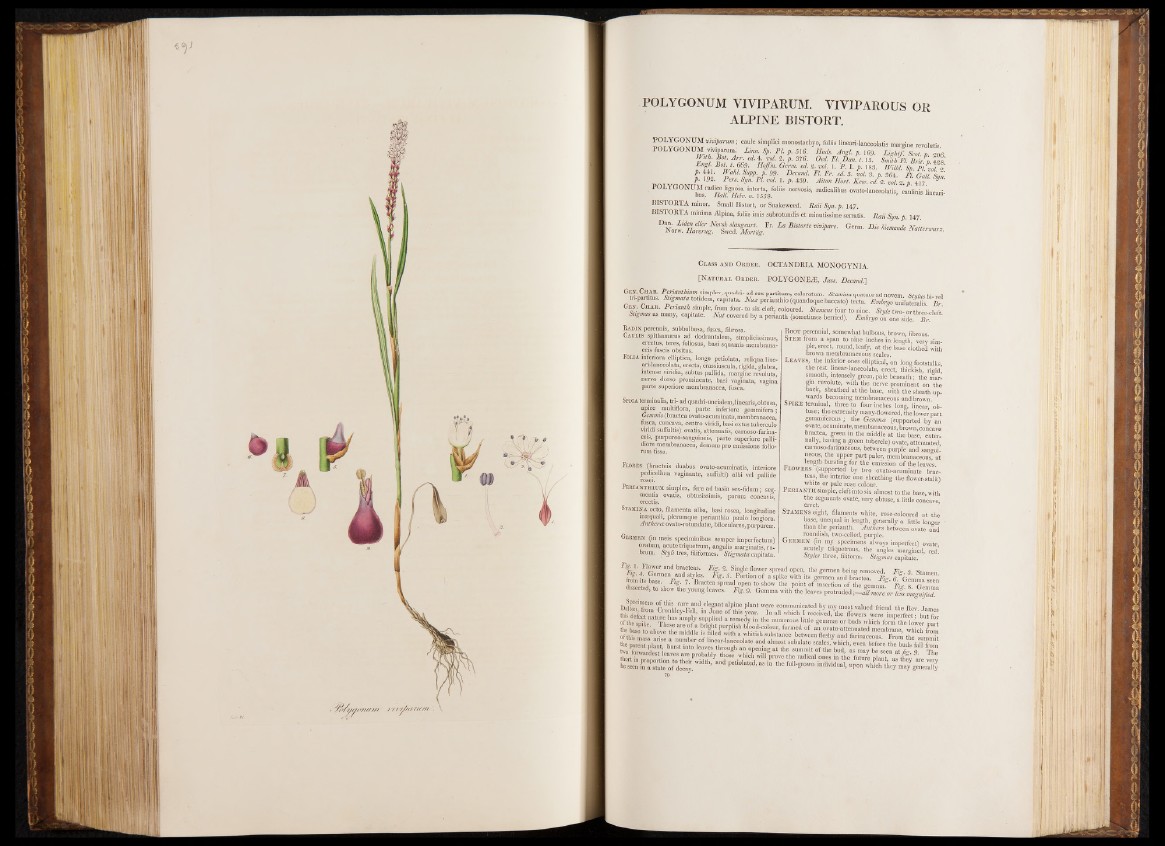
POLYGONUM VIVIPARUM. VIVIPAROUS OR
ALPINE BISTORT.
W l «*"le B H monoslachyo, foliis lineari-lanceolatis margine revolutis
POLYGONUM vmparumi Linn. Sp. PI. p. 516. Huds. Angl. p. 169. L ig h tf Scot » onff
W M Bot. A r r e d .* .}o l. 2. % 376. Oed. FI. W M 13 S A l B r i A . f i '
Engl. Bot. t. 669- Hofftn. Germ. ed. 2. vol. 1. P. I. p. 183. lVilld Sd PI wni <?'
p . 441. Wahl. Supp. p. 99. Decand. FI. Fr. ed. 3. vol. 3 p .Ml %[ GalLSvn
■Pers. Syn. PI. vol. 1. p . 439. Alton Hort. Kew. ed. 2. vol. 2. p. 4 17 ' ^
POLYGONUM radkeHgnoW intorta, foliis nervosis, radicalibus ovato-lanceolatis, caulinis linear]-
BISTORTA minor. Small Bistort, or Snakeweed. Rail S yn.p. 147.
BISTORTA minima Alpina, foliis imis subrotundis et minutissime serratis. Raii Syn. p . 147.
D N o r S « ^ l t a d “X % Pr' ^ BiSt0rt‘ Germ' D “ kiemmde Nattenmrx.
Class an d Ord e e . OCTANDRIA MONOGYNIA.
[Natural Order. POLYGONEÆ, Just. Decand.’]
G? ' C5 “ ' “ “ Pi611, qnadri- ad sex-partitum, coloratum. Stamina quatuor ad novem B H
tn-partitus. Stigmata totidem, capitata. N u t perianthio (quandoque baccato) tecta. Embryo unilatefaiis B r
Gen. Char. Perianth simple, from four- to six-cleft, coloured. Stamens four to nine. Style two- or three A f t
Stigmas as many, capitate. N u t covered by a perianth (sometimes berried). Embryo on one Aie, B r
Radix perennis, aubbulbosa, fusca, fibrosa.
Gai/lis spithamasus ad dodrantalem, simplicissimus,
erectus, teres, foliosus, basi squamis merabrana-
ceis fuscis obsitus.
Folia inferiora elliptica, longe petiolata, reliqua line-
ari-lanceolata, erecta, crassiuscula, rigida, glabra,
intense viridia, subtus pallida, margine revoluta,
nervo dorso prominente, basi vaginata, vagina
parte superiore membranacea, fusca.
Spica terminalis, tri— ad quadri-uncialem, linearis, obtusa,
apice multiflora, parte inferiore gemmifera;
Gemmis (bractea ovato-acuminata, membranacea,
fusca, concava, centro viridi, basi extus tuberculo
viridi suffultis) ovatis, attenuatis, carnoso-farina- ,
ceis, purpureo-sanguineis, parte superiore palli-.
diore membranacea, demum pro emissione folio-'
rum fissa.
Flores (bracteis duabus ovato-acuminatis, interiore
pedicellum vaginante, suffulti) albi vel pallide
Perianthium simplex, fere ad basin sex-fidum; segments
ovatis, obtusissimis, parura concavis,
erectis.
Stamina octo, filamenta alba, basi rosea, longitudine
inffiquali, plerumque perianthio paulo longiora.
Antheree ovato-rotundataj, biloculares, purpurese.
Germen (in meis speciminibus semper imperfectum)
ovatum, acute triquetrum, angulis marginatis, ru-
brum. Styli tres, filiformes. Stigmata capitata.
Root perennial, somewhat bulbous, brown, fibrous.
Stem from a span to nine inches in length, very simple,
erect, round, leafy, at the base clothed with
brown membranaceous scales.
L eaves, the inferior ones elliptical, on long footstalks,
the rest linear-lanceolate, erect, thickish, rigid
smooth, intensely green, pale beneath; the margin
revolute, with the nerve prominent on the
back, sheathed at the base, with the sheath upwards
becoming membranaceous and brown
Sp ik e terminal, three to four inches long, linear, obtuse;
the extremity many-flowered, the lower part
gemmiferous ; the Gemma (supported by an
ovate, acuminate, membanaceous, brown, concave
bractea, green in the middle a t the base, externally,
having a green tubercle) ovate, attenuated,
carnoso-farinaceous, between purple and sanguineous,
the upper part paler, membranaceous? at
length bursting for the emission of the leaves
r lowers (supported by two ovato-acuminate brac-
teas, the interior one sheathing the flower-stalk)
white or pale rose colour. I J
Pe r ia n t h simple, cleft into six almost to the base, with
the segments ovate, very obtuse, a little concave,
erect.
Stamens eight, filaments white, rose-coloured at the
base, unequal in length, generally a little longer •
than the perianth. Anthers between ovate and
roundish, two-celled, purple.
Ge rm en (in my specimens always imperfect) ovate
acutely triquetrous, the angles margined, red.
Styles three, filiform. Stigmas capitate.
S B H B E m B B I -%■ 2. Single flower spread open, the germen being removed. Fig 3 Stamen fig. 4. Germen and styles. Fig. 5. Portion of a spike with its eermen and brief.» SM r V 5 tt '
from its base Fig. 7. Bractea spread open to show the point a s s e r tio n o f t e K B !een
d ie te d , to show the young leaves. J)V,9 . Gemma with the leaves protrudedT - a ^ Z r e o r ^ s L ^ T
DaltaTom P'“ 1 « re communicated by my most valued friend the Rev. James
this defect mtture has amply’supplied a r e n j y in the
8H B— I 8 H M B » " probably those which will prove the radical ones in the future rtant as ihfv a re v
S u T a C e “ 0^ ’' ’ >“ ■ ' - *baM-grown individual. u p o r ^ L ^ m a f S
79